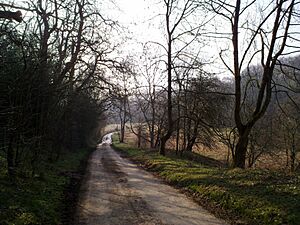Knitsley facts for kids
Quick facts for kids Knitsley |
|
|---|---|
 |
|
| Civil parish |
|
| Unitary authority |
|
| Ceremonial county | |
| Region | |
| Country | England |
| Sovereign state | United Kingdom |
| EU Parliament | North East England |
Knitsley is a small village, also known as a hamlet, located in County Durham, England. It's found a short distance south of the town of Consett. Knitsley used to be its own civil parish, which is like a local government area, but now it's part of the Healeyfield parish. Back in 1931, about 2,276 people lived here.
The name Knitsley comes from an old English phrase. It means "the meadow where knights were" or "the knight's field."
Contents
Knitsley's History
Early Records
Knitsley has a long history, with its name appearing in old documents from the 1200s. Around 1250, a record mentions Adam of Knychley holding land near Iveston. Later, in 1280, other documents list people named Hugh of Cnicheley and William of Knicheley. William even witnessed a document for John de Chilton from Healeyfield.
In 1381, a survey by Bishop Hatfield showed that Robert of Kellawe owned the village of Knycheley. Over the years, the land changed hands many times. Important families like the Surtees, Eure, and Claxton families owned it. The Claxton family held the manor until the 1620s. In the 1800s, the land belonged to the Earls of Coventry. They eventually sold it to the people living there in 1920.
Land Changes and Woodlands Hall
In 1773, a law called the Inclosure Act was passed. This law meant that common lands, which everyone could use, were divided up and sold. Thomas White, a landscape gardener who designed beautiful outdoor spaces, bought over 200 acres of this land.
In 1779, he built a house called Woodlands Hall. He also planted many different kinds of trees and created lovely gardens. After Thomas White's son passed away in 1831, the house and land were owned by several different families. One owner was John Richardson, who lived there until 1871. Later, William Brewis Van Haansbergen bought the estate and lived there until he died in 1921.
Local Life and Transport
Knitsley once had a Primitive Methodist meeting house, a place of worship, which was built in 1842. It was called Salem Chapel on old maps from 1857. This building was taken down in the 1950s.
Today, there's a pub called The Old Mill, which is a bit outside the main village. A long time ago, there was also a public telephone box at the end of Hownsgill Drive. However, it was removed because people stopped using it.
A railway station opened in Knitsley in 1862. It was part of the North Eastern Railway. This station served the area until 1964. At that time, many railway lines across Britain were closed down. The old railway line is now a walking and cycling path called the Lanchester Valley Railway Path.
Knitsley as a Civil Parish
Knitsley used to be part of a larger area called Conside-cum-Knitsley township. This was within the parish of Lanchester. In 1894, Knitsley became its own civil parish. However, on April 1, 1937, the parish was officially ended. It was then combined with the nearby areas of Healeyfield and Consett.

